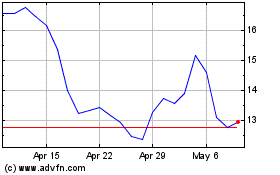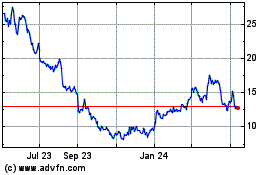- Study Met Primary Endpoints of Safety and Tolerability
- Dose-Dependent Improvement in Total Symptom Score Observed with
EDP-235 Treatment Compared to Placebo, Achieving Statistical
Significance as Early as One Day After First Dose
- No Difference in Viral Load Reduction; Rapid Decline Observed
in All Study Arms
- Conference Call and Webcast Today at 4:30 p.m. ET
Enanta Pharmaceuticals, Inc. (NASDAQ: ENTA), a clinical-stage
biotechnology company dedicated to creating small molecule drugs
for viral infections, today announced topline data from SPRINT
(SARS-Cov-2 PRotease INhibitor
Treatment), a double-blind, placebo-controlled Phase 2
clinical trial of EDP-235, Enanta’s oral, 3CL protease inhibitor,
in non-hospitalized, symptomatic adults with mild or moderate
COVID-19 who were not at high risk for severe disease.
EDP-235 met the primary endpoint of the trial and was generally
safe and well-tolerated. A dose-dependent improvement in symptoms
was observed with EDP-235 treatment compared to placebo, which
achieved statistical significance (p<0.05) in the 400mg
treatment group at multiple time points, starting as early as one
day after the first dose. In a prespecified population consisting
of patients enrolled within 3 days of symptom onset, a
statistically significant improvement was observed with EDP-235 at
400mg at all time points. While no difference was observed in time
to improvement of 14 targeted COVID-19 symptoms, an analysis of a
subset of these symptoms showed a 2-day shorter time to improvement
in patients receiving EDP-235 400mg who were enrolled within 3 days
of symptom onset (p<0.01). No effect on virologic endpoints as
measured in the nose was detected due to the rapid viral decline in
the placebo arm of this highly immunologically-experienced,
standard risk population.
“The data from our Phase 2 SPRINT trial demonstrated a favorable
safety profile and an improvement in clinical symptoms, suggesting
that EDP-235 may have an impact on clinically meaningful
endpoints,” said Scott T. Rottinghaus, M.D., Senior Vice President
and Chief Medical Officer of Enanta Pharmaceuticals. “The findings
from this trial also highlight the challenge of demonstrating a
virologic effect in an otherwise healthy, highly immune-experienced
adult population who are not at risk for severe disease. We are
continuing to evaluate data from the trial and are focusing on
partnership opportunities for Phase 3 and on the potential for a
different Phase 2 study in acute or long COVID that could further
demonstrate the efficacy of EDP-235.”
EDP-235 SPRINT Phase 2 Study Topline Results
SPRINT was a Phase 2, randomized, double-blind,
placebo-controlled study in non-hospitalized, symptomatic patients
with mild to moderate COVID-19 who were not at an increased risk
for severe disease. The primary objective of the study was to
evaluate the safety and tolerability of EDP-235, with key secondary
objectives of symptoms, antiviral activity, and pharmacokinetics of
EDP-235.
A total of 231 subjects were randomized 1:1:1 to receive 200mg
or 400mg EDP-235 or placebo orally once daily for 5 days (n=77 in
200mg, n=78 in 400mg, n=76 in placebo) and followed through Day 33.
The modified intent-to-treat efficacy analysis included treated
patients who were subsequently confirmed to be COVID-19 positive
using a central RT-PCR test (n=62 in 200mg, n=67 in 400mg, n=61 in
placebo). An additional prespecified population of patients who
were randomized within 3 days after the onset of symptoms was
evaluated (n=47 in 200mg, n=47 in 400mg, n=45 in placebo).
Demographics and baseline characteristics were well balanced
between the arms. Overall, most of the patients were White,
Hispanic, young (median age approximately 45 years old), body mass
index of around 25 kg/m2, enrolled within 3 days of symptom onset
(approximately 73%), and seropositive (approximately 95%).
EDP-235 at 200mg or 400mg was generally safe and well-tolerated
in patients receiving 5 days of dosing. A low frequency of
treatment emergent adverse events (TEAEs) was observed (1.3% and
6.4% in the EDP-235 200mg and 400mg arms, respectively, vs. 2.6% in
placebo). Most TEAEs were mild in severity, with no serious TEAEs
or discontinuations due to TEAEs. Laboratory values were generally
unremarkable, although one patient receiving EDP-235 400mg who also
used concomitant alcohol and acetaminophen experienced transient
asymptomatic elevation of ALT (grade 4), AST (grade 3) and GGT with
normal bilirubin and alkaline phosphatase. Transient elevations in
total cholesterol and triglycerides were seen with EDP-235
treatment, trending toward baseline after completion of
treatment.
A dose-dependent improvement in the key secondary endpoint of
total symptom score (TSS) was demonstrated in patients treated with
EDP-235 compared to placebo, despite the lack of virologic effect
as measured in the nose. This improvement achieved statistical
significance (p<0.05) in the 400mg treatment group at multiple
time points, starting as early as one day after initiation of
EDP-235 treatment. In the prespecified patient population enrolled
within 3 days of symptom onset, a statistically significant
improvement in TSS was observed with EDP-235 400mg compared to
placebo at all measured time points (Days 1 -32 post dosing). While
no difference was observed in time to improvement of 14 targeted
COVID-19 symptoms, an analysis of a subset of 6 of these symptoms
showed a 2-day shorter time to improvement in patients receiving
EDP-235 400mg who were enrolled within 3 days of symptom onset
(p<0.01 versus placebo).
Key secondary endpoints evaluating virologic effect were not
met. No difference was observed between patients treated with
EDP-235 and placebo in viral RNA decline or infectious viral load,
likely due to the rapid viral decline in the placebo arm of this
trial’s seropositive, standard risk population. The mean baseline
viral load in this study population was approximately 5 log, and a
precipitous decrease in viral RNA was observed in all study arms,
indicating this highly immune population rapidly cleared virus from
the nose. An additional analysis of patients with a baseline viral
load greater than 5 log showed a decline of 0.4 log at Day 3 in
both EDP-235 treatment arms compared to placebo.
EDP-235 displayed pharmacokinetic profiles at the 200mg and
400mg doses consistent with previous studies, demonstrating 7x and
12x multiples over the protein-adjusted EC90.
Full data from SPRINT will be presented at a future medical
meeting or in a peer-reviewed publication.
Conference Call and Webcast Information
Enanta will host a conference call and webcast today at 4:30
p.m. ET. The live webcast can be accessed under "Events &
Presentations" in the investors section of Enanta’s website. To
participate by phone, participants should register for the call
here. It is recommended that participants register a minimum of 15
minutes before the call. Once registered, participants will receive
an email with the dial-in information. The archived webcast will be
available on Enanta’s website for approximately 30 days following
the event.
About Enanta Pharmaceuticals, Inc.
Enanta is using its robust, chemistry-driven approach and drug
discovery capabilities to become a leader in the discovery and
development of small molecule drugs for the treatment of viral
infections. Enanta’s research and development programs include
clinical candidates for the following disease targets: respiratory
syncytial virus (RSV), SARS-CoV-2 (COVID-19) and hepatitis B virus
(HBV). Enanta is also conducting research on a single agent
targeting both RSV and human metapneumovirus (hMPV).
Enanta receives royalties from hepatitis C virus (HCV) products
developed under its collaboration with AbbVie. Glecaprevir, a
protease inhibitor discovered by Enanta, is part of one of the
leading treatment regimens for curing chronic HCV infection and is
sold by AbbVie in numerous countries under the tradenames MAVYRET®
(U.S.) and MAVIRET® (ex-U.S.) (glecaprevir/pibrentasvir). Please
visit www.enanta.com for more information.
Forward Looking Statements
This press release contains forward-looking statements,
including statements with respect to the prospects for further
development of EDP-235. Statements that are not historical facts
are based on management’s current expectations, estimates,
forecasts and projections about Enanta’s business and the industry
in which it operates and management’s beliefs and assumptions. The
statements contained in this release are not guarantees of future
performance and involve certain risks, uncertainties and
assumptions, which are difficult to predict. Therefore, actual
outcomes and results may differ materially from what is expressed
in such forward-looking statements. Important factors and risks
that may affect actual results include: the impact of development,
regulatory and marketing efforts of others with respect to
competitive treatments for COVID-19; the discovery and development
risks for EDP-235; any continuing impact of the COVID-19 pandemic
on business operations and clinical trials; Enanta’s lack of
clinical development experience; Enanta’s need to attract and
retain senior management and key research and development
personnel; Enanta’s need to obtain and maintain patent protection
for its product candidates and avoid potential infringement of the
intellectual property rights of others; and other risk factors
described or referred to in “Risk Factors” in Enanta’s Form 10-K
for the fiscal year ended September 30, 2022, and any other
periodic reports filed more recently with the Securities and
Exchange Commission. Enanta cautions investors not to place undue
reliance on the forward-looking statements contained in this
release. These statements speak only as of the date of this
release, and Enanta undertakes no obligation to update or revise
these statements, except as may be required by law.
View source
version on businesswire.com: https://www.businesswire.com/news/home/20230508005600/en/
Media and Investors Contact Jennifer Viera 617-744-3848
jviera@enanta.com
Enanta Pharmaceuticals (NASDAQ:ENTA)
Historical Stock Chart
From Oct 2024 to Nov 2024

Enanta Pharmaceuticals (NASDAQ:ENTA)
Historical Stock Chart
From Nov 2023 to Nov 2024
